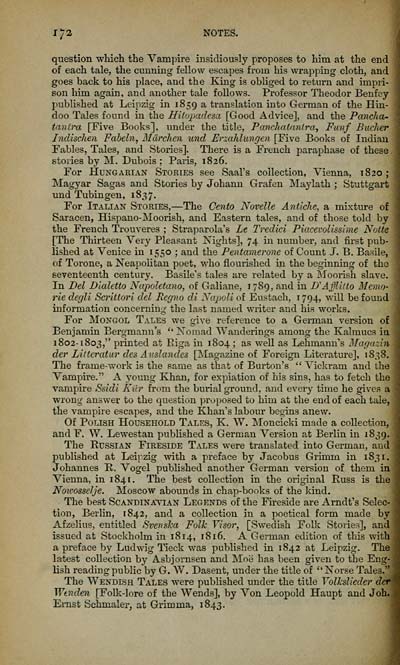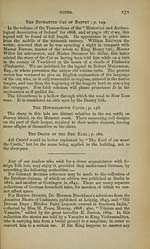Download files
Complete book:
Individual page:
Thumbnail gallery: Grid view | List view

1/2 NOTES.
question which the Vampire insidiously proposes to him at the end
of each tale, the cunning fellow escapes from his wrapping cloth, and
goes back to his jjlace, and the Kmg is obliged to return and impii-
son him again, and another tale follows. Professor Theodor Benfoy
published at Leipzig in 1859 ^ translation into German of the Hin-
doo Tales found in the Hitopadesa [Good Advice], and the Pancha-
tanira [Five Books], under the title, Pancliataiitra, Fuvf BucJtcr
IncUschen Fabeln, Mdrclien und Erzahhmgen [Five Books of Indian
Fables, Tales, and Stories]. There is a French paraphase of these .
stories by M. Dubois ; Paris, 1826.
For Hungarian Stories see Saal's collection, Vienna, 1820 ;
Magyar Sagas and Stories by Johann Grafen ^Maylath ; Stuttgart
und Tubingen, 1837,
For Italian Stories, — The Cento Novelle Anticlie, a mixture of
Saracen, Hispano-Moorish, and Eastern tales, and of those told by
the French Trouveres ; Straparola's Le Tredici PiacevoUssirae N<Ate
[The Thirteen Very Pleasant Nights], 74 in number, and first pub-
lished at Venice in 1550 ; and the Pentamerone of Count J. B, Basile,
of Torone, a Neapolitan poet, who flourished in the beginning of the
seventeenth century. Basile's tales are related by a iMoorish slave.
In Del Dlaletto Napoletano, of Galiane, 1789, and in D'Affli/to Mcnm-
rie degli Scrittori del Regno di Xapoli of Eustach, 1 794, will be foui.d
information concerning the last named writer and his works.
For Mongol Tales we give reference to a German version of
Benjamin Bergmann's '* Nomad Wanderings among the Kalmucs ia
1802-1803," printed at Riga in 1804 ; as well as Lehmann's Ma[i<i:'ii
der Lilteratur des Axislandes [Magazine of Foreign Literature], iS.v^.
The frame-work is the same as that of Burton's " Vickram and tlie
Vampire." A yoimg Khan, for expiation of his sins, has to fetch tlie
vampire Ssidl Kiir from the burial ground, and every time he give.^ a
wrong answer to the question proposed to him at the end of each taie,
the vampire escapes, and the Khan's labour begins anew.
Of Polish Household Tales, K. W. Moncicki made a collection,
andF. W. Lewestan published a German Version at Berlin in 1830.
The Russian Fireside Tales were translated into German, arul
published at Leipzig vsdth a preface by Jacobus Grimm in 18,^1.
Johannes R. Vogel published another German version of them in
Vienna, in 1841. The best collection in the original Russ is the
Noicosselje. Moscow abounds in chap-books of the kind.
The best Scandinatian Legends of the Fireside are Arndt's Selec-
tion, Berlin, 1842, and a collection in a poetical form made by
Afzelius, entitled Svensla Folk Visor, [Swedish Folk Stories], and
issued at Stockholm in 1814, 1816. A German edition of this with
a preface by Ludwig Tieck was iDublished in 1842 at Leipzig. The
latest collection by Asbjornsen and Moe has been given to the Eir^-
lish reading public by G. W. Dasent, under the title of "Norse Tales."
The Wendish Tales were published under the title Vollslieder dcr
Wtnden [Folk-lore of the Wends], by Von Leopold Haupt and Job.
Ernst Schmaler, at Grim ma, 1843.
question which the Vampire insidiously proposes to him at the end
of each tale, the cunning fellow escapes from his wrapping cloth, and
goes back to his jjlace, and the Kmg is obliged to return and impii-
son him again, and another tale follows. Professor Theodor Benfoy
published at Leipzig in 1859 ^ translation into German of the Hin-
doo Tales found in the Hitopadesa [Good Advice], and the Pancha-
tanira [Five Books], under the title, Pancliataiitra, Fuvf BucJtcr
IncUschen Fabeln, Mdrclien und Erzahhmgen [Five Books of Indian
Fables, Tales, and Stories]. There is a French paraphase of these .
stories by M. Dubois ; Paris, 1826.
For Hungarian Stories see Saal's collection, Vienna, 1820 ;
Magyar Sagas and Stories by Johann Grafen ^Maylath ; Stuttgart
und Tubingen, 1837,
For Italian Stories, — The Cento Novelle Anticlie, a mixture of
Saracen, Hispano-Moorish, and Eastern tales, and of those told by
the French Trouveres ; Straparola's Le Tredici PiacevoUssirae N<Ate
[The Thirteen Very Pleasant Nights], 74 in number, and first pub-
lished at Venice in 1550 ; and the Pentamerone of Count J. B, Basile,
of Torone, a Neapolitan poet, who flourished in the beginning of the
seventeenth century. Basile's tales are related by a iMoorish slave.
In Del Dlaletto Napoletano, of Galiane, 1789, and in D'Affli/to Mcnm-
rie degli Scrittori del Regno di Xapoli of Eustach, 1 794, will be foui.d
information concerning the last named writer and his works.
For Mongol Tales we give reference to a German version of
Benjamin Bergmann's '* Nomad Wanderings among the Kalmucs ia
1802-1803," printed at Riga in 1804 ; as well as Lehmann's Ma[i<i:'ii
der Lilteratur des Axislandes [Magazine of Foreign Literature], iS.v^.
The frame-work is the same as that of Burton's " Vickram and tlie
Vampire." A yoimg Khan, for expiation of his sins, has to fetch tlie
vampire Ssidl Kiir from the burial ground, and every time he give.^ a
wrong answer to the question proposed to him at the end of each taie,
the vampire escapes, and the Khan's labour begins anew.
Of Polish Household Tales, K. W. Moncicki made a collection,
andF. W. Lewestan published a German Version at Berlin in 1830.
The Russian Fireside Tales were translated into German, arul
published at Leipzig vsdth a preface by Jacobus Grimm in 18,^1.
Johannes R. Vogel published another German version of them in
Vienna, in 1841. The best collection in the original Russ is the
Noicosselje. Moscow abounds in chap-books of the kind.
The best Scandinatian Legends of the Fireside are Arndt's Selec-
tion, Berlin, 1842, and a collection in a poetical form made by
Afzelius, entitled Svensla Folk Visor, [Swedish Folk Stories], and
issued at Stockholm in 1814, 1816. A German edition of this with
a preface by Ludwig Tieck was iDublished in 1842 at Leipzig. The
latest collection by Asbjornsen and Moe has been given to the Eir^-
lish reading public by G. W. Dasent, under the title of "Norse Tales."
The Wendish Tales were published under the title Vollslieder dcr
Wtnden [Folk-lore of the Wends], by Von Leopold Haupt and Job.
Ernst Schmaler, at Grim ma, 1843.
Set display mode to: Large image | Transcription
Images and transcriptions on this page, including medium image downloads, may be used under the Creative Commons Attribution 4.0 International Licence unless otherwise stated. ![]()
| Early Gaelic Book Collections > J. F. Campbell Collection > Fireside stories of Ireland > (190) |
|---|
| Permanent URL | https://digital.nls.uk/79185340 |
|---|
| Description | Volumes from a collection of 610 books rich in Highland folklore, Ossianic literature and other Celtic subjects. Many of the books annotated by John Francis Campbell of Islay, who assembled the collection. |
|---|
| Description | Selected items from five 'Special and Named Printed Collections'. Includes books in Gaelic and other Celtic languages, works about the Gaels, their languages, literature, culture and history. |
|---|

